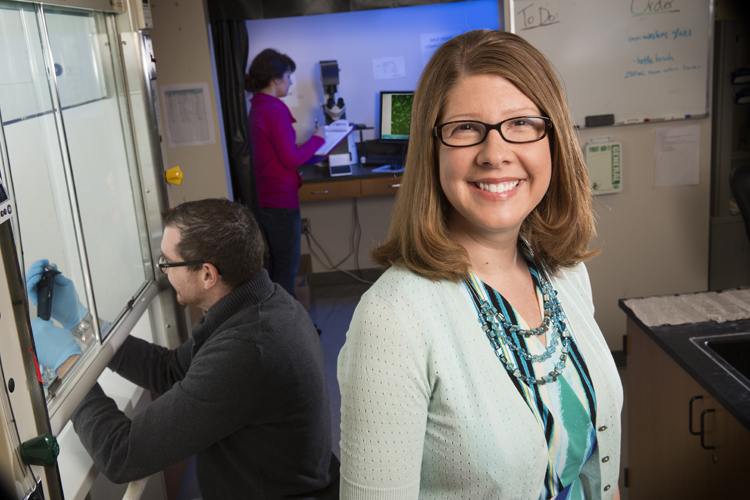
Employing DNA that codes for genes to correct genetic problems, treat disease or aid healing holds tremendous potential, but finding an effective, safe method of delivering genes to cells remains a significant hurdle. A UNL engineer is using nanotechnology to develop a gene delivery tool that could unleash the power of gene therapy.
Angela Pannier, assistant professor of biological systems engineering, recently earned a five-year, $419,051 Faculty Early Career Development Program Award from the National Science Foundation to continue her research. These prestigious awards, also known as CAREER awards, support junior faculty who exemplify the role of teacher-scholars through outstanding research, excellent teaching and the integration of education and research.
Pannier is developing 3-D nanostructured surfaces that use the spaces between nano-sized columns to hold large amounts of DNA, similar to a toothbrush loaded with toothpaste. Touching the nanostructure to the cell unloads the DNA.
She’s also designing the surfaces so that touching the ends of the columns, or bristles, to the cell alters it in ways that make it more or less receptive to receiving genes. The genes could come from the nanostructured surface itself, or elsewhere, such as the bloodstream.
“We hypothesize that if you put a cell down on a nanostructured surface that’s just loaded with DNA, you are providing the cells more opportunity to take up the genetic material,” Pannier said. “We also think that if, at the same time, you are making an optimal environment for the cells, they’ll take up even more DNA. The combination of that is incredibly novel and has huge potential.”
This gene delivery method allows cells to use the gene to make beneficial proteins without incorporating the gene into its chromosome and could provide a longer-term therapeutic solution than drugs. This approach also is safer than methods that use viruses, which integrate genes into the cells’ DNA structure or cause secondary reactions, Pannier said.
The therapeutic potential is enormous, she added. For example, medical devices could incorporate these nanostructured surfaces to deliver genes that promote integration with bone following a hip implant; reduce inflammation after placing a heart stent to unclog a blocked artery; or promote tissue growth in tissue engineering procedures.
It also could be used to deliver genes to cure genetic diseases, such as cystic fibrosis or hemophilia, or even treat some cancers, cardiovascular conditions, and other diseases.
The nanostructure surfaces also could be used in biotechnology research and in sensors to help detect molecules in the environment, such as toxic gases or microbial contaminants.
Pannier, a member of the university’s Center for Nanohybrid Functional Materials, is collaborating with UNL electrical engineers and center members Mathias Schubert and Eva Franke-Schubert to fabricate and study the nanostructured surfaces.
“We think that (these surfaces) are going to change the field of biomaterials and drug and gene delivery because you can deliver so many different things. It’s unlimited, really,” she said.
With her CAREER award, Pannier also is developing courses to enhance UNL’s biomedical engineering curriculum by emphasizing learning through primary literature and hands-on laboratory exercises. She also will provide research experiences for high school and undergraduate students, as well as design outreach workshops and curriculums for high school teachers to use in their classrooms.
— Gillian Klucas, Research and Economic Development